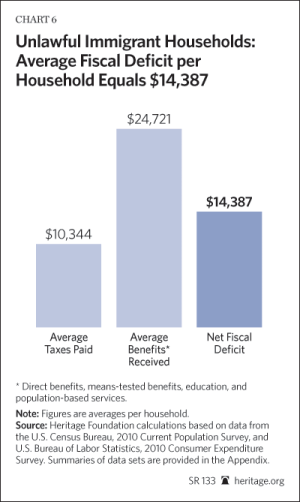Formula:
Human Life Value (HLV) Approach = Present Value of (Future Income - Personal Expenses - Taxes) over the remaining working years.
Given the relatively small number of deaths caused by immigrants, their $96 billion contribution in tax revenues far outweighs any death-related negative economic impacts, Juicebox.
I’ll be fair because nobody knows what is cost or what the value is of Illegals in the country. According to AI it cost 70 billion to educate illegals. It’s interesting that in the 96 billion it says immigrants and undocumented immigrants.
AI
Reports from 2024 and 2025 estimate the annual costs of illegal immigration to U.S. taxpayers ranging from a net cost of around $150 billion to gross costs exceeding $450 billion
. However, determining the total amount is complex and highly debated, with different analyses producing widely varying figures depending on the data and methodology used.
Variations in cost estimates
Organizations arrive at different figures due to their approach to key issues, including:
- Total population: Estimates of the undocumented immigrant population size vary, impacting the final cost calculations.
- Inclusion of U.S. citizen children: Some estimates include the costs associated with U.S.-born children of undocumented immigrants, which significantly increases the overall total.
- Fiscal burden vs. economic contribution: Some analyses focus exclusively on the costs to taxpayers, while others account for economic contributions such as taxes paid and labor supplied.
Net vs. gross costs
Different methodologies lead to either a net cost (expenditures minus taxes paid) or a gross cost (total expenditures).
Net cost estimates
Groups that consider both spending and tax revenue report a net fiscal burden:
- Federation for American Immigration Reform (FAIR): A 2023 report estimated a net cost of $150.7 billion, based on $182 billion in total expenditures offset by $32 billion in taxes paid by undocumented households. In early 2025, FAIR updated its estimate to $182 billion annually, reflecting a larger population.
- House Budget Committee: In 2024, citing FAIR's data, a report put the annual cost at $150.7 billion.
Gross cost estimates
Groups that focus on gross spending, particularly since 2021, report much higher figures:
- Center for Immigration Studies (CIS): Research cited in a 2025 White House fact sheet and a 2023 House Homeland Security report placed the cost to taxpayers at up to $451 billion.
- Congressional Budget Office (CBO): A June 2025 report analyzed the effects of the recent immigration "surge" on state and local budgets in 2023, finding a direct net cost of $9.2 billion. Gross spending for this population was $19.3 billion, with the largest costs going toward education and shelter.
Examples of specific cost categories
Expenditures attributed to illegal immigration span multiple government services at federal, state, and local levels:
- Healthcare: Costs for emergency care covered by Medicaid are billions annually, with one estimate placing the amount at over $16.2 billion under the Biden-Harris administration.
- Education: K-12 education for the children of illegal immigrants is a major expense for state and local governments, estimated at around $70 billion annually.
- Enforcement: Immigration enforcement agencies receive significant federal funding, with the U.S. Border Patrol's budget exceeding $7 billion in fiscal year 2024.
- Shelter: Local and state governments, such as New York City and New York State, have spent billions on emergency housing for asylum seekers and other immigrants.
Economic contributions
Analyses from some sources indicate that immigrants, including the undocumented, also contribute significantly to the economy:
- Taxes paid: A 2024 report by the Institute on Taxation and Economic Policy (ITEP) found that undocumented immigrant households paid $96.7 billion in federal, state, and local taxes in 2022.
- GDP growth: The CBO projected in 2024 that an increase in immigration would boost GDP by $9 trillion and reduce federal deficits by $0.9 trillion over the 2024-2034 period.
- Consumer spending: A 2025 analysis by the American Immigration Council found that undocumented households had $256.8 billion in spending power in 2022 after paying taxes.


